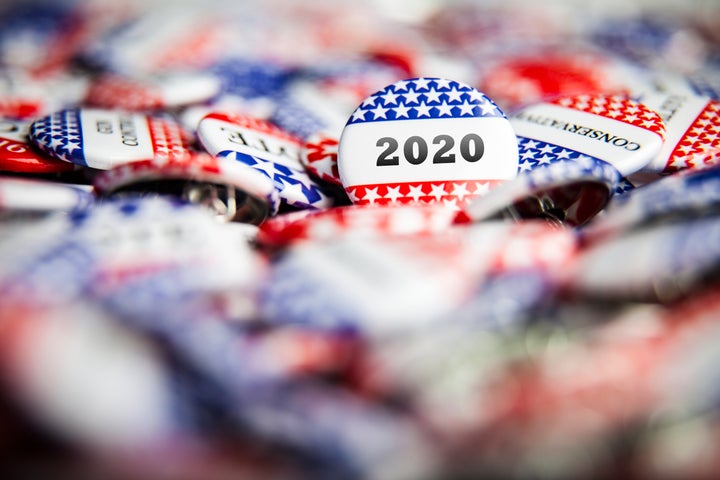
Over the weekend, the most closely watched poll of the Iowa caucus was abruptly shelved over concerns about a possible mistake. As Washington Post reporter Mike Madden noted, that’s as good a metaphor as any for the larger state of Iowa caucus polling: rife with uncertainty and a hard-to-quantify potential for error.
Even with one fewer poll than planned, there’s no shortage of data on the race. But rather than providing clear guidance about who’s likely to win, the picture it presents is of a closely fought, volatile race, with former Vice President Joe Biden and Vermont Sen. Bernie Sanders (I-Vt.) narrowly edging their rivals, and considerable possibility for movement.
Taken in aggregate, the polls suggest that Sanders and Biden are virtually tied in standing, with former South Bend, Indiana, Mayor Pete Buttigieg and Massachusetts Sen. Elizabeth Warren well within striking distance. FiveThirtyEight’s average puts Sanders at 22%, Biden at 21%, and both Buttigieg and Warren near 15%.
Underlying those tight numbers is considerable variation between many of the surveys conducted in the past few weeks. The final New York Times/Siena College poll found Sanders with a 7-point lead over Biden; a Suffolk University/USA Today poll had Biden up about 6 points over Sanders. In between, Monmouth University and CBS/YouGov surveys found the two candidates more or less deadlocked.
Nothing about the polling augurs a clear winner ― which doesn’t make the data useless. Without it, it’d be equally plausible to assume that one of those contenders was on track to a runaway victory. Still, if there’s any point of agreement between pollsters, it’s that this isn’t a simple race to call in advance.
“Caucus electorates are the most difficult to model in polling,” Monmouth University polling director Patrick Murray wrote. “The smartest takeaway from this, or any Iowa poll for that matter, is to be prepared for anything on Monday.”
“Our data indicate it’s still a very tight race, and we’re prepared for pretty much anything tomorrow night,” CBS’ Kabir Khanna wrote on Twitter on Sunday.
A few reasons why there’s so much uncertainty:
Voters could change their minds. Across polls, a significant percentage of voters say they’re not entirely committed to their first choice of candidate. The Democratic pollster Civiqs, for instance, found that 40% of voters said their minds were less than firmly made up; Suffolk University/USA TODAY polling a week before the caucus saw a majority either undecided or saying they might change their minds. It’s also worth noting that much of the polling on the race wrapped up a few days ago, meaning any significant last-minute swings toward a candidate might not be fully reflected.
The caucusing process is complicated. In a primary, the voting process more or less resembles the process of being polled: voters pick one candidate from a list. Iowa’s Democratic caucus is more complicated, including provisions for voters to realign their support if their first-choice candidate fails to hit 15% of the initial vote.
It’s not clear what the electorate will look like. “It all comes down to turnout” is in the pantheon of election truisms, but it’s especially true of relatively low-turnout events like a caucus. In surveys of Iowa, pollsters’ methods for determining who’s likely to vote appear to make an especially significant difference on the results.
Monmouth University based their topline findings on an electorate that resembles 2008. But the poll also examined several possible turnout scenarios, with the results of even a small swing in turnout ranging from a +6 Biden lead to a +4 Sanders edge. There’s a glaring generational divide between Biden and Sanders supporters, which makes age a crucial demographic to watch: the Biden campaign needs older, habitual voters to dominate the caucuses, while the Sanders campaign is looking for new voters, like college students, to flock to the polls.
The New York Times’ Nate Cohn, who’s written extensively about modeling likely voters in the race, explains how sampling and assumptions about turnout can help explain the variation in polls: Pollsters who pick their respondents based on a history of voting in other races have tended to find results more favorable to Biden. Relying on voters’ self-reported likelihood of showing up to caucus, by contrast, seems to give an advantage to Sanders. It’s an open question whether Iowans’ history of regularly voting in elections or their self-reported enthusiasm for the caucus is a better gauge for who’ll actually show up this time.
The potential for uncertainty and error may be especially heightened by the circumstances of the Iowa caucus, but it’s likely to remain a theme in election polling throughout the year. Following the 2016 general election, when a perfect storm of issues led to a polling miss in key states and left many voters feeling misled, the survey industry has broadly adopted some fixes, like urging pollsters to weight their results on voters’ levels of education. But there’s also been a renewed effort to highlight the fact that polls are, by nature, neither a precision tool nor a guarantee.
